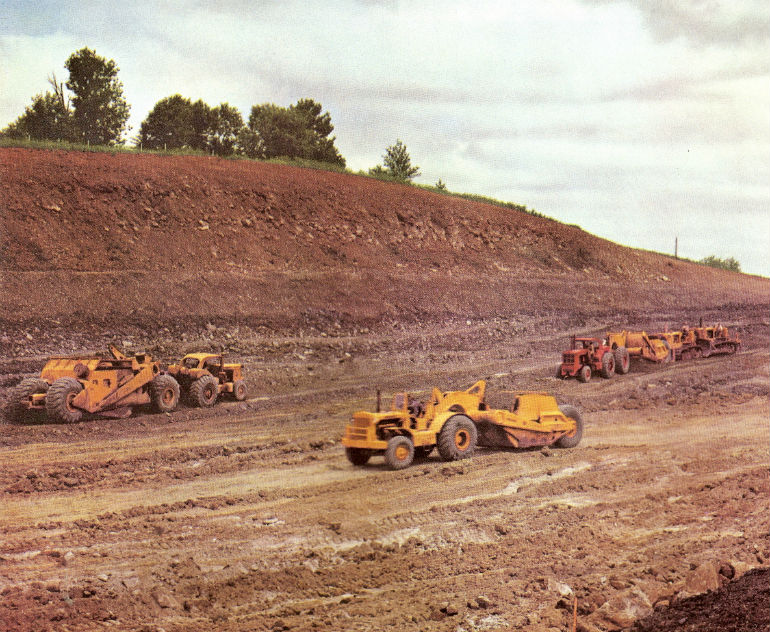Specialising in assembled machines, primarily for the US military, the Mississippi Road Supply Company (MRS) produced a range of motorscrapers including the monstrous Model 250, the largest motorscraper available in 1959. BY RICHARD CAMPBELL.
MRS, the Mississippi Road Supply Company of Flora, Mississippi, USA, is a name unfamiliar to New Zealand contractors.
MRS was first set up in 1943 to build construction and conveying equipment and has concentrated on contracts for the US military over the years, with supply to the domestic market of secondary importance.
Interestingly, all MRS’s designs have been 2-axle tractor units with a trailing scraper and most featured all-wheel steering.
MRS machines were primarily “assembled” machines – customers could specify how their machine was configured and which powerplant or transmission package was fitted. Common engine suppliers were International Harvester, Cummins and General Motors, and there have also been machines powered with Buda, Mack and Waukesha diesels.
Transmission suppliers included Fuller, Twin-Disc and Allison.
This kitset approach also extended to the axles, drivelines and hydraulic equipment.
In fact the only thing that MRS actually made itself was the chassis and scraper hitches.
Even the scrapers were built for MRS by Wooldridge of Sunnyvale California, initially all cable controlled with – you guessed it – your choice of winch.
It wasn’t until the late 1960s that MRS began building its own scraper bowls (following Wooldridge’s sale to Curtiss-Wright) and by this time they were of all-hydraulic operation.
Your MRS could also be specified with a Hancock elevating scraper should you so choose.
After their use by the US military, many of these machines found their way into the domestic construction scene via US Government disposal sales, especially in the middle 1970s following the Vietnam conflict.
By all accounts these machines were very ruggedly built and were popular among smaller contractors who were on a budget.
A list of some of the models offered for sale to commercial customers include:
I-25: one of the first machines offered and usually powered by an International UD-16 engine. Manual transmission, Wooldridge eight- to 10-cubic-yard cable scraper.
I-80: usually GM powered and equipped with either a Wooldridge 10-cubic-yard cable scraper or Hancock 12E2 elevator.
I-95S: Cummins or GM power, MRS’s own 16-cubic-yard scraper.
I-105: Almost all powered with a GM 6V-71 diesel and attached to a 20-cubic-yard conventional or elevating scraper. This combination weighed 43 tons empty!
I-110: See the New Zealand connection below.
Model 250 – This was a true monster of a machine. When introduced in 1959 it was the largest production motorscraper in the world and featured a whopping 48-cubic-yard Wooldridge cable scraper. This combination tipped the scales at over 60 tons empty.
Subsequent versions had hydraulic bowls and all featured “tractionaid”, an MRS invention which transferred some of the scraper’s weight to the driving axle of the tractor via a single acting hydraulic ram.
The model 250 was dropped from the range around 1970.
The New Zealand Connection
While not strictly a scraper, one example of an MRS tractor was imported into New Zealand.
It was an ex-military machine – a MRS I-110 which had been converted to a self-propelled compactor and came into the country around 1974. Owned by Barry Andrews Earthmovers of Rotorua, it was powered by a GM 12V-71 diesel with an Allison powershift transmission.
It was first used on the Police Training College site at Porirua, Wellington and subsequently on other jobs. When last seen it was languishing in the back lot of a second hand machinery dealer in Rotorua.
Brief Specifications – MRS I-110 (fully equipped)
Engine: General Motors 12V-71 diesel rated at 412fwhp
Transmission: Allison VCLBT4465 powershift, 6-speed
Brakes: All-axle wedge actuated shoes
Std. Tyres: 29-5 x 29 (6)
Scraper: MRS S-110, 24 cubic yard, open bowl, fully hydraulic
Length: 48’
Width: 11’10”
Op. Weight: 46 tons


Parting words from Jeremy Sole- a final column